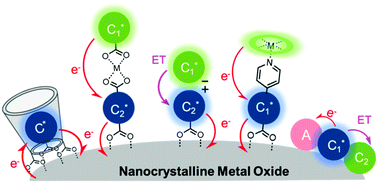当前位置:
X-MOL 学术
›
Chem. Soc. Rev.
›
论文详情
Our official English website, www.x-mol.net, welcomes your feedback! (Note: you will need to create a separate account there.)
Multimolecular assemblies on high surface area metal oxides and their role in interfacial energy and electron transfer
Chemical Society Reviews ( IF 46.2 ) Pub Date : 2017-09-22 00:00:00 , DOI: 10.1039/c7cs00565b Jamie C. Wang 1, 2, 3, 4 , Sean P. Hill 1, 2, 3, 4 , Tristan Dilbeck 1, 2, 3, 4 , Omotola O. Ogunsolu 2, 3, 4, 5 , Tanmay Banerjee 1, 2, 3, 4, 6 , Kenneth Hanson 1, 2, 3, 4, 5
Chemical Society Reviews ( IF 46.2 ) Pub Date : 2017-09-22 00:00:00 , DOI: 10.1039/c7cs00565b Jamie C. Wang 1, 2, 3, 4 , Sean P. Hill 1, 2, 3, 4 , Tristan Dilbeck 1, 2, 3, 4 , Omotola O. Ogunsolu 2, 3, 4, 5 , Tanmay Banerjee 1, 2, 3, 4, 6 , Kenneth Hanson 1, 2, 3, 4, 5
Affiliation

|
High surface area metal oxides offer a unique substrate for the assembly of multiple molecular components at an interface. The choice of molecules, metal oxide, and the nature of the assembly method can have a profound influence on the mechanism, rate, and efficiency of photoinduced energy and electron transfer events at the interface. Owing to their diversity and high level of control, these interfacial assemblies are of interest for numerous applications including solar energy conversion, photoelectrosynthesis, photo-writable memory, and more. Although these assemblies are generated with very different goals in mind, they rely on similar surface binding motifs and molecular structure–property relationships. Therefore, the goal of this review is to summarize the various strategies (i.e. co-deposition, axial coordination, metal ion linkages, electrostatics, host–guest interactions, etc.) for assembling chromophores, hosts, electron donors/acceptors, and insulating co-adsorbent molecules on mesoporous metal oxide substrates. The assembly, synthesis, and characterization, as well as subsequent photoinduced events (i.e. cross-surface energy/electron transfer, interchromophore energy transfer, electron injection, and others) are discussed for the various assembly strategies.
中文翻译:

高表面积金属氧化物上的多分子组装及其在界面能和电子转移中的作用
高表面积的金属氧化物为在界面处组装多种分子组分提供了独特的基材。分子,金属氧化物的选择以及组装方法的性质会对界面处的光诱导能量和电子转移事件的机理,速率和效率产生深远的影响。由于它们的多样性和高度的控制能力,这些界面组件对于包括太阳能转换,光电合成,光可写存储等在内的许多应用都是令人感兴趣的。尽管生成这些程序集的目的很不相同,但它们依赖于相似的表面绑定基序和分子结构与属性的关系。因此,本次审查的目的是总结各种策略(即共沉积,轴向配位,金属离子键,静电,主体与客体的相互作用等),用于在中孔金属氧化物基质上组装发色团,主体,电子供体/受体和绝缘共吸附分子。讨论了各种组装策略的组装,合成和表征,以及随后的光诱导事件(即跨表面能量/电子转移,发色团能量转移,电子注入等)。
更新日期:2017-09-22
中文翻译:

高表面积金属氧化物上的多分子组装及其在界面能和电子转移中的作用
高表面积的金属氧化物为在界面处组装多种分子组分提供了独特的基材。分子,金属氧化物的选择以及组装方法的性质会对界面处的光诱导能量和电子转移事件的机理,速率和效率产生深远的影响。由于它们的多样性和高度的控制能力,这些界面组件对于包括太阳能转换,光电合成,光可写存储等在内的许多应用都是令人感兴趣的。尽管生成这些程序集的目的很不相同,但它们依赖于相似的表面绑定基序和分子结构与属性的关系。因此,本次审查的目的是总结各种策略(即共沉积,轴向配位,金属离子键,静电,主体与客体的相互作用等),用于在中孔金属氧化物基质上组装发色团,主体,电子供体/受体和绝缘共吸附分子。讨论了各种组装策略的组装,合成和表征,以及随后的光诱导事件(即跨表面能量/电子转移,发色团能量转移,电子注入等)。


























 京公网安备 11010802027423号
京公网安备 11010802027423号